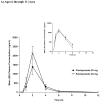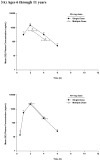A multicenter, randomized, open-label, pharmacokinetics and safety study of pantoprazole tablets in children and adolescents aged 6 through 16 years with gastroesophageal reflux disease
- PMID: 20852004
- PMCID: PMC3190583
- DOI: 10.1177/0091270010377501
A multicenter, randomized, open-label, pharmacokinetics and safety study of pantoprazole tablets in children and adolescents aged 6 through 16 years with gastroesophageal reflux disease
Abstract
Children with gastroesophageal reflux disease (GERD) may benefit from gastric acid suppression with proton pump inhibitors such as pantoprazole. Effective treatment with pantoprazole requires correct dosing and understanding of the drug's kinetic profile in children. The aim of these studies was to characterize the pharmacokinetic (PK) profile of single and multiple doses of pantoprazole delayed-release tablets in pediatric patients with GERD aged 6 to 11 years (study 1) and 12 to 16 years (study 2). Patients were randomly assigned to receive pantoprazole 20 or 40 mg once daily. Plasma pantoprazole concentrations were obtained at intervals through 12 hours after the single dose and at 2 and 4 hours after multiple doses for PK evaluation. PK parameters were derived by standard noncompartmental methods and examined as a function of both drug dose and patient age. Safety was also monitored. Pantoprazole PK was dose independent (when dose normalized) and similar to PK reported from adult studies. There was no evidence of accumulation with multiple dosing or reports of serious drug-associated adverse events. In children aged 6 to 16 years with GERD, currently available pantoprazole delayed-release tablets can be used to provide systemic exposure similar to that in adults.
Figures







Similar articles
-
Randomized, open-label, multicentre pharmacokinetic studies of two dose levels of pantoprazole granules in infants and children aged 1 month through <6 years with gastro-oesophageal reflux disease.Clin Pharmacokinet. 2011 Aug;50(8):541-50. doi: 10.2165/11591900-000000000-00000. Clin Pharmacokinet. 2011. PMID: 21740077 Clinical Trial.
-
Single-dose, multiple-dose, and population pharmacokinetics of pantoprazole in neonates and preterm infants with a clinical diagnosis of gastroesophageal reflux disease (GERD).Eur J Clin Pharmacol. 2010 Jun;66(6):555-61. doi: 10.1007/s00228-010-0811-8. Epub 2010 Mar 20. Eur J Clin Pharmacol. 2010. PMID: 20306184 Clinical Trial.
-
Pharmacokinetics and tolerability of rabeprazole sodium in subjects aged 12 to 16 years with gastroesophageal reflux disease: an open-label, single- and multiple-dose study.Clin Ther. 2007 Sep;29(9):2082-92. doi: 10.1016/j.clinthera.2007.09.007. Clin Ther. 2007. PMID: 18035206 Clinical Trial.
-
Pantoprazole: a proton pump inhibitor with oral and intravenous formulations.Expert Rev Gastroenterol Hepatol. 2007 Dec;1(2):197-205. doi: 10.1586/17474124.1.2.197. Expert Rev Gastroenterol Hepatol. 2007. PMID: 19072410 Review.
-
Pantoprazole: a proton pump inhibitor.Clin Drug Investig. 2009;29 Suppl 2:3-12. doi: 10.2165/1153121-S0-000000000-00000. Clin Drug Investig. 2009. PMID: 19938880 Review.
Cited by
-
Assessing CYP2C19 Ontogeny in Neonates and Infants Using Physiologically Based Pharmacokinetic Models: Impact of Enzyme Maturation Versus Inhibition.CPT Pharmacometrics Syst Pharmacol. 2019 Mar;8(3):158-166. doi: 10.1002/psp4.12350. Epub 2018 Dec 5. CPT Pharmacometrics Syst Pharmacol. 2019. PMID: 30520273 Free PMC article.
-
Obese Children Require Lower Doses of Pantoprazole Than Nonobese Peers to Achieve Equal Systemic Drug Exposures.J Pediatr. 2018 Feb;193:102-108.e1. doi: 10.1016/j.jpeds.2017.10.011. J Pediatr. 2018. PMID: 29389444 Free PMC article. Clinical Trial.
-
A randomized, crossover pharmacodynamic study of immediate-release omeprazole/sodium bicarbonate and delayed-release lansoprazole in healthy adult volunteers.Pharmacol Res Perspect. 2016 May 19;4(3):e00238. doi: 10.1002/prp2.238. eCollection 2016 Jun. Pharmacol Res Perspect. 2016. PMID: 27433347 Free PMC article.
-
Reply.J Pediatr. 2018 Jul;198:327-328. doi: 10.1016/j.jpeds.2018.03.001. Epub 2018 Apr 18. J Pediatr. 2018. PMID: 29680472 Free PMC article. No abstract available.
-
Effect of proton pump inhibition on acid, weakly acid and weakly alkaline gastro-esophageal reflux in children.World J Pediatr. 2013 Feb;9(1):36-41. doi: 10.1007/s12519-013-0405-5. Epub 2013 Feb 7. World J Pediatr. 2013. PMID: 23389331
References
-
- Vandenplas Y, Rudolph CD, Di Lorenzo C, et al. Pediatric gastroesophageal reflux clinical practice guidelines: joint recommendations of the North American Society of Pediatric Gastroenterology, Hepatology, and Nutrition and the European Society of Pediatric Gastroenterology, Hepatology, and Nutrition. J Pediatr Gastroenterol Nutr. 2009;49:498–547. - PubMed
-
- Sherman PM, Hassall E, Fagundes-Neto U, et al. A global, evidence-based consensus on the definition of gastroesophageal reflux disease in the pediatric population. Am J Gastroenterol. 2009;104:1278–1295. - PubMed
-
- Diaz DM, Winter HS, Colletti RB, et al. Knowledge, attitudes and practice styles of North American pediatricians regarding gastroesophageal reflux disease. J Pediatr Gastroenterol Nutr. 2007;45:56–64. - PubMed
-
- Richter JE, Fraga P, Mack M, Sabesin SM, Bochenek W Pantoprazole US GERD Study Group. Prevention of erosive oesophagitis relapse with pantoprazole. Aliment Pharmacol Ther. 2004;20:567–575. - PubMed
-
- Hassall E, Kerr W, El-Serag HB. Characteristics of children receiving proton pump inhibitors continuously for up to 11 years duration. J Pediatr. 2007;150:262–267.e1. - PubMed
Publication types
MeSH terms
Substances
Grants and funding
LinkOut - more resources
Full Text Sources
Medical

